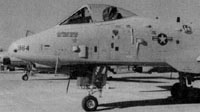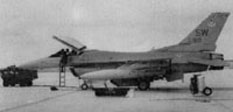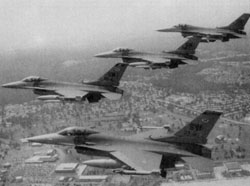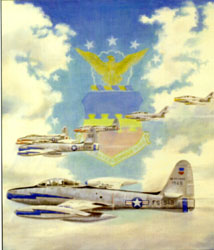 Fighter Wing can trace its lineage
to 28 July 1947, when the 20th Fighter Wing, began at Shaw Field, South Carolina, as a
Ninth Air Force unit. Components of the new fighter wing included the 20th Maintenance and
Supply Group, the 20th Airdrome Group, and the 20th Station Medical Group (later Tactical
Hospital). At the same time, the 20th Fighter Group with the 55th, 77th, and 79th Fighter
Bomber Squadrons and P-51 Mustangs formed the combat element of the 20th Fighter Wing. The
group exchanged its P-51's in February 1948 for F-84B (later D) Thunderjets.
Fighter Wing can trace its lineage
to 28 July 1947, when the 20th Fighter Wing, began at Shaw Field, South Carolina, as a
Ninth Air Force unit. Components of the new fighter wing included the 20th Maintenance and
Supply Group, the 20th Airdrome Group, and the 20th Station Medical Group (later Tactical
Hospital). At the same time, the 20th Fighter Group with the 55th, 77th, and 79th Fighter
Bomber Squadrons and P-51 Mustangs formed the combat element of the 20th Fighter Wing. The
group exchanged its P-51's in February 1948 for F-84B (later D) Thunderjets.  On 24 August 1948,
a reorganization of the 20th Maintenance and Supply Group featured the activation of the
20th Supply Squadron, Fighter, Jet (later simplified to 20th Supply Squadron) and the 20th
Maintenance Squadron, Fighter, Jet (renamed 20th Maintenance Squadron in 1950, 20th Field
Maintenance Squadron in 1954, and 20th Equipment Maintenance Squadron in 1981).
On 24 August 1948,
a reorganization of the 20th Maintenance and Supply Group featured the activation of the
20th Supply Squadron, Fighter, Jet (later simplified to 20th Supply Squadron) and the 20th
Maintenance Squadron, Fighter, Jet (renamed 20th Maintenance Squadron in 1950, 20th Field
Maintenance Squadron in 1954, and 20th Equipment Maintenance Squadron in 1981). Two days later, on 26 August 1948, the wing's 20th Airdrome Group was discontinued and its security police (now the 20th Security Police Squadron), installations, food service and air base elements became realigned under the 20th Air Base Group. The creation of the new group fostered the activation of the 20th Finance Disbursing Unit (today's 20th Comptroller Squadron), the 20th Motor Vehicle Squadron (predecessor of the 20th Transportation Squadron), the 20th Installations Squadron (redesignated 20th Civil Engineering Squadron fourteen years later), the 20th Food Service Squadron (antecedent of the 20th Services Squadron), and the 20th Communications Squadron (no relation to the communications organizations serving the wing today).
20th Becomes Fighter Bomber Wing
Control over the wing changed hands on 1 February 1949 with its assignment to Fourteenth Air Force. Eleven months later, on 20 January 1950, the wing was redesignated as the 20th Fighter Bomber Wing. Similar redesignations altered the titles of the 20th Group and its three flying squadrons.
 Subordinancy to Fourteenth Air Force was short-lived, and on 1 August 1950 the wing was
reassigned directly under Tactical Air Command. Ninth Air Force resumed control over the
20th on 22 January 1951. Control was swapped back to Tactical Air Command on 1 December
1951, just after the wing's relocation from Shaw to Langley AFB, Virginia. At Langley, the
wing began flying new Republic F-84Gs in addition to F-84Ds. An internal change during the
wing's short stay at Shaw Field featured the 3 November 1949 inactivation of the 20th
Finance Disbursing Unit.
Subordinancy to Fourteenth Air Force was short-lived, and on 1 August 1950 the wing was
reassigned directly under Tactical Air Command. Ninth Air Force resumed control over the
20th on 22 January 1951. Control was swapped back to Tactical Air Command on 1 December
1951, just after the wing's relocation from Shaw to Langley AFB, Virginia. At Langley, the
wing began flying new Republic F-84Gs in addition to F-84Ds. An internal change during the
wing's short stay at Shaw Field featured the 3 November 1949 inactivation of the 20th
Finance Disbursing Unit. Move to Wethersfield - May 1952
The 20th Fighter Bomber Wing made its second move, this time overseas to RAF Wethersfield in Essex, England, on 31 May 1952. Its fighter bomber group set up headquarters, along with the 55th and 77th Squadrons, at Wethersfield a day later. Restricted space there compelled the 79th Squadron to move into RAF Bentwaters in Suffolk, England the squadron moved to RAF Woodbridge, three miles southeast of Bentwaters, on 1 October 1954. On 5 June, Tactical Air Command relinquished control over the wing to Third Air Force and the United States Air Forces in Europe.
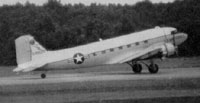 On 15 November 1952,
the wing and group merged unofficially placing the flying squadrons directly under the
wing's operational and administrative control. The group remained on the Air Force's
active list however, until 8 February 1955 when the three fighter-bomber squadrons were
officially realigned under the wing.
On 15 November 1952,
the wing and group merged unofficially placing the flying squadrons directly under the
wing's operational and administrative control. The group remained on the Air Force's
active list however, until 8 February 1955 when the three fighter-bomber squadrons were
officially realigned under the wing. Wing Bestowed With Group's Heritage
The Department of the Air Force temporarily bestowed the lineage and honors of the 20th Group on the 20th Wing in November 1954. That action was accomplished to facilitate the Air Force's adoption of a wing-base plan, making the wing the primary combat element of operational organizations. Consequent to the action of temporary bestowal, the 20th Tactical Fighter Wing laid claim to the lineage, honors, and history of the 20th Fighter Group. That bestowal has remained in effect ever since.
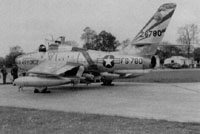 In June 1955, the wing started flying F-84F Thunderstreaks in addition to its
F-84Ds and F-84Gs. The F-84G was phased out by June 1955 and the F-84F remained in the
inventory until December 1957.
In June 1955, the wing started flying F-84F Thunderstreaks in addition to its
F-84Ds and F-84Gs. The F-84G was phased out by June 1955 and the F-84F remained in the
inventory until December 1957. The F-100 Arrives
 Prior to the departure of the F-84 fleet, the 20th began conversion to North
American F-1OOD and F-1OOF Super Sabres on 16 June 1957.
Prior to the departure of the F-84 fleet, the 20th began conversion to North
American F-1OOD and F-1OOF Super Sabres on 16 June 1957. Meanwhile, on 26 January 1956, the wing underwent a major internal reorganization with the inactivation of the 20th Maintenance and Supply Group and the realignment of the 20th Field Maintenance and 20th Supply Squadrons under the air base group which was then redesignated the 20th Support Group.
 At the same time, the 20th Installations
Squadron and 20th Food Service Squadron were also inactivated (they reemerged as the 20th
Civil Engineering Squadron and 20th Services Squadron on 16 January 1962 and 1 February
1982, respectively), the 20th Air Base Squadron was activated, and the 20th Communications
Squadron was redesignated as the 20th Operations Squadron (this squadron remained with the
wing until its inactivation on 1 July 1958).
At the same time, the 20th Installations
Squadron and 20th Food Service Squadron were also inactivated (they reemerged as the 20th
Civil Engineering Squadron and 20th Services Squadron on 16 January 1962 and 1 February
1982, respectively), the 20th Air Base Squadron was activated, and the 20th Communications
Squadron was redesignated as the 20th Operations Squadron (this squadron remained with the
wing until its inactivation on 1 July 1958). Wheelus Operation Begins
The 20th Fighter Bomber Wing established an operational detachment at Wheelus AB, Libya in February 1958. On 8 February 1958, the 20th Field Maintenance Squadron was realigned again, this time directly under the wing. Three months later, the wing took on the designation of the 20th Tactical Fighter Wing. The 55th, 77th and 79th Squadrons were also re-labeled as tactical fighter squadrons at that time. Two additional maintenance squadrons were added to the wing with the activation of the 20th Armament and Electronic Maintenance Squadron (renamed 20th Avionics Maintenance Squadron in 1981) and the 20th Periodic Maintenance Squadron (which became the 20th Organizational Maintenance Squadron in 1964 and the 20th Aircraft Generation Squadron in 1981). The flying squadrons dispersed on a monthly rotational basis to RAF Alconbury, RAF Woodbridge, and Nouasseur AB, Morrocco, due to a RAF Wethersfield runway closure from May to August, 1958.
The 20th Stands Alert
The wing first established its Blast Off (later named Victor Alert) capability in July, 1958. The first mobility plan was initiated on 1 January 1959. A year-round weapons training detachment was established at Wheelus AB, Libya, for monthly squadron rotations. Pilot survival and ski training began in Norway in February, 1959. The 20th Tactical Fighter Wing represented USAFE in the William Tell exercise held at Nellis AFB, Nevada in October, 1960.
The first NATO Tiger meet was sponsored by the 79th Tactical Fighter Tiger Squadron at RAF Woodbridge in June, 1961 (established by Captains Michael T Dugan and Merril A McPeak, each of whom went on to become Air Force Chief of Staff).
Maintenance Structural Reorganization - The First of Many
Intermediate command over the 20th changed hands between 3rd Air Force and 16th Air Force from 1 July 1961 to 1 September 1963. In the meantime, internal changes again altered the structure of the wing. January 16th marked the activation of the 20th Civil Engineering Squadron, a unit which had been dormant for six years. On 15 June 1962, the 20th Support Group was redesignated as the 20th Combat Support Group and the 20th Supply Squadron was realigned under the wing and its newly appointed office of Deputy Commander for Materiel (DCM). On the same day, the 20th Consolidated Aircraft Maintenance Squadron came into being, along with the inactivation of the 20th Field Maintenance, Periodic Maintenance, and Armament and Electronic Maintenance Squadrons, and the consolidation of their assets under the new squadron. The CAMS Squadron fell under the DCM. Direction and control over the wing's three flying squadrons went to another newly formed office - Deputy Commander for Operations (DCO)- on the same day.
Maintenance consolidation lasted only two years, and on 8 July 1964, the wing dissolved the Consolidated Aircraft Maintenance Squadron. Two months earlier, on 14 May 1964, the 20th Armament and Electronics Maintenance Squadron and the 20th Field Maintenance Squadron re-emerged and the wing activated the 20th Organizational Maintenance Squadron (formerly Periodic). On 8 July 1964, two new maintenance squadrons joined the wing organization - the 320th Munitions Maintenance Squadron and the 20th Flight line Maintenance Squadron. The latter was stationed at RAF Woodbridge with the 79th Tactical Fighter Squadron for less than two years. It was inactivated on 15 December 1965, when the 79th TFS absorbed its personnel and equipment.
The complexion of the 20th's maintenance community changed again on 1 January 1966 with the inactivation of the 20th Organizational Maintenance Squadron. The wing parceled out the personnel and equipment of that squadron to maintenance components of the 55th and 77th Tactical Fighter Squadrons.
Rotations to Turkey Begin
Monthly rotations to Cigli AB, Turkey were conducted from July 1966 to June 1970 and to Aviano AB, Italy from December 1966 to June 1970. Political closures of US bases in France forced opening of RAF Greenham Common under 20th TFW management to handle personnel overflow in January 1967.
On 1 July 1967, the administrative sections of the wing and combat support group merged to form the 20th Base Headquarters Squadron. Though it never achieved formal squadron status by definition, that organization retained its unofficial designation until its demise on 1 June 1989 when it was functionally replaced by the 20th Mission Support Squadron. A final, though minor, organizational revision during the decade of the 60s featured the redesignation of the 20th Armament and Electronics Squadron as the 20th Avionics Maintenance Squadron on 1 January 1969.
Wheelus Closes
A military coup in Libya forced the closure of Wheelus AB in September 1969 and initiation of 20th TFW weapons training detachment operations at Torrejon AB, Spain in November, 1969.
Detachment 1, 20th Tactical Fighter Wing was established at RAF Upper Heyford on 10 December 1969.
All three flying squadrons rotated to Zaragoza, Spain for weapons training from January to March 1970.
Relocation to Upper Heyford - F-111 Era Begins
 Headquarters, 20th
Tactical Fighter Wing relocated from RAF Wethersfield to RAF Upper Heyford on 1 June 1970.
For the first time since it left Virginia in 1952, all three of its flying squadrons were
united on one base. Less than three months later, the wing began converting to a new
aircraft - the General Dynamics F-111E Aardvark (unofficially). On 12 September 1970, the
first two F-111Es arrived at RAF Upper Heyford. The last of the 20th's F-100s transferred
to the Air National Guard on 12 February 1971 and in November of that year the wing's
F-111s were declared operationally ready.
Headquarters, 20th
Tactical Fighter Wing relocated from RAF Wethersfield to RAF Upper Heyford on 1 June 1970.
For the first time since it left Virginia in 1952, all three of its flying squadrons were
united on one base. Less than three months later, the wing began converting to a new
aircraft - the General Dynamics F-111E Aardvark (unofficially). On 12 September 1970, the
first two F-111Es arrived at RAF Upper Heyford. The last of the 20th's F-100s transferred
to the Air National Guard on 12 February 1971 and in November of that year the wing's
F-111s were declared operationally ready. Reorganization of the wing's maintenance community continued and on 1 February 1972, the 20th Organizational Maintenance Squadron was activated for a second time., shifting maintenance personnel and equipment back out of the flying squadrons. Eight months later, on 1 September 1972, the 320th Munitions Maintenance Squadron was redesignated as the 20th Munitions Maintenance Squadron.
The 20th TFW participated in F-111 NATO and US unilateral operations Shabaz, Display Determination, Cold Fire, Ocean Safari, Datex, Priory, Reforger, Dawn Patrol, Highwood, Hammer, and others from January 1972 to October 1993.
In March 1973, the 20th TFW became one of only two wings in the Air Force to participate in the tri-deputy wing organization system. The Deputy Commander for Materiel organization split apart to form the Deputy Commander for Logistics (renamed Deputy Commander for Resources in 1974 and Deputy Commander for Resource Management in 1975) and the Deputy Commander for Maintenance organizations. Under this test the Organizational, Field, Avionics, and Munitions Maintenance Squadrons became prime components of the Deputy Commander for Maintenance organization. The procurement and comptroller offices, along with the 20th Supply and 20th Transportation Squadrons (moved under the Combat Support Group) constituted the Deputy Commander for Logistics organization. The tri-deputy system was formally approved in the following year and the 20th Transportation Squadron was officially realigned from the Combat Support Group to the Deputy Commander for Resources on 24 July, 1974.
Operations shifted to RAF Greenham Common from May to August, 1976, due to runway repairs at Upper Heyford.
Maintenance Reorganizes - Again
Another major maintenance organizational restructuring occurred on 31 October 1981. HQ USAFE redesignated the 20th Avionics Maintenance Squadron as the 20th Component Repair Squadron; renamed the 20th Organizational Maintenance Squadron as the 20th Generation Squadron; and the 20th Field Maintenance as the 20th Equipment Maintenance Squadron. At the same time, it activated the 520th Aircraft Generation Squadron and inactivated the 20th Munitions Maintenance Squadron.
On 1 February 1982, HQ USAFE activated the 20th Services Squadron of the 20th Combat Support Group. A former component of the 20th TFW, this squadron traced its roots back to June 1948, when it was first constituted as the 20th Food Service Squadron.
The EF-111A Ravens Arrive - A Squadron Gained
The wing gained a fourth flying squadron on 1 July 1983, with the activation of the 42nd Electronic Combat Squadron. On February 1984, the first Grumman (General Dynamics) EF-111A Ravens of that squadron arrived at Upper Heyford. Parental responsibility over the 42nd by the 20th TFW was short-lived, however, and on 1 June 1985, operational control of the squadron shifted to the 66th Electronic Combat Wing at Sembach AB, West Germany.
Summer of 1985 featured two organizational changes. First on 1 July, HQ USAFE activated the 20th Comptroller Squadron - 35 years after its disbandment as the 20th Finance Disbursing Unit (Fighter - Jet), Shaw AFB, SC. The second change involved the activation of the 7320th Security Police Group and the 7320th Security Police Squadron. Control over the 20th Security Police Squadron, already serving the wing, shifted from the 20th Combat Support Group to the new Security Police Group. The commander's title changed to Deputy Commander for Security Police in March 1986.
Raid on Libya
In March 1986, the 66th Electronic Combat Wing detached the 42nd ECS to the 20th TFW to take part in Eldorado Canyon, the raid on Libya. On 14 April 1986, 5 EF-111As and 20 F-111Es took off from RAF Upper Heyford as part of the attack force. They were used as an airborne reserve for the F-111Fs of the 48th TFW, RAF Lakenheath. Three EF-111s (two were spares and turned back) formed up with the 48th's F-111Fs and provided electronic defense during the attack on Tripoli.
USAFE initiated the Project Power Hunter intelligence network in December 1987. The wing first tested the Durandal runway-buster bombs during Exercise Red Flag, in January and February 1988.
The lifelines of the 7320th Security Police Group and Squadron were terminated on 21 October 1988, when they were inactivated and functionally replaced by the 20th Security Police Group and the 620th Security Police Squadron. The 20th Security Police Squadron was realigned under the new group.
WTD in Turkey
All three fighter squadrons deployed to Incirlik AB, Turkey for Weapons Training Deployment (WTD) on Konya Range from March to May 1989.
On 1 June 1989, HQ USAFE dissolved the 20th Base Headquarters Squadron and activated the 20th Mission Support Squadron under the 20th Combat Support Group. The new organization provided squadron level control over various base administrative agencies formerly regulated by the combat support group directly. Among these were Military Personnel, Civilian Personnel, Base Administration (renamed Information Management), Education Services, Social Actions, Family Support, Dependent Schools Office, and the NCO Preparatory School.
The first F-111E modified under he Aircraft Modernization Program (AMP) arrived at Upper Heyford in February 1990.
The 79th Tactical Fighter Squadron sent aircrews to participate in Cold Fire '90 events from 11 to 26 January 1990.
From 2 - 20 March 1990, aircrews of the 20th Tactical Fighter Wing participated in Red Flag 90-3.
The 79th Tactical Fighter Squadron participated in a Mallet Blow exercise from 26 - 29 March 1990. This exercise tested the United Kingdom's air defenses.
On 15 April, 20th TFW air and ground crews undertook Weapons System Evaluation Program (WSEP) training during Combat Hammer 90-7 at Mountain Home AFB, Idaho.
From 2 - 16 May, the 77th Tactical Fighter Squadron deployed to Aviano AB, Italy, to participate in a Southern Region exercise called Dragon Hammer 90.
Aircrews of the 79th Tactical Fighter Squadron flew in a Baltic maritime exercise called Brazen Deed on 12 June 1990.
The 870th Contingency Hospital, located at RAF Little Rissington, was assigned to the 20th TFW on 1 July 1990.
The 79th Tactical Fighter Squadron hosted the 1990 NATO Tiger Meet from 12 - 17 September 1990.
On 25 September, the 2168th Communications Squadron, RAF Croughton, was assigned to the 20th TFW.
Iraq Invasion of Kuwait - Desert Shield Begins
The 20th TFW had aircraft deployed to Incirlik AB, Turkey for a Weapons Training Deployment in August 1990, when Iraq invaded Kuwait and Desert Shield started. As the start of the air campaign neared, the wing reinforced its presence as all US aircraft at Incirlik were incorporated into the 7440th Wing (Provisional), Operation Proven Force, for the duration of the war. The wing also deployed four 42nd ECS EF-111As and 80 personnel to Taif, Saudi Arabia, to support Operation Desert Storm.
Desert Storm
On 25 January 1991, the wing was once again up to four flying squadrons when the 42nd Electronic Combat Squadron was reassigned to the 20th from the 66th Electronic Combat Wing.
On 16 January 1991, a 42nd ECS EF-111A, operating from Taif, was credited with the first aerial kill of the war. It was attacked a by an Iraqi Mirage fighter while flying a night mission near the Saudi-Iraq border. To defeat the Iraqi fighter, the EF-111A descended to minimum altitude on its Terrain Following Radar (TFR). The Mirage slammed into the ground while trying to follow the EF-111A.
On 17 January 1991, 20th TFW aircraft launched combat missions from both Turkey and Saudi Arabia and continued flying combat missions until the cease fire. The F-111s flying from Turkey flew night missions throughout the war, using the TFR to penetrate the dense antiaircraft artillery (AAA) environment at altitudes around 200 feet for the first few nights. Crews who flew those first few terrifying nights said that the illumination from the AAA was so bright that they didn't need the TFR to avoid the ground. After the missile threat was suppressed, crews flew their attacks at altitudes around 20,000 feet, above the range of most Iraqi AAA systems.
During the war, the F-111s attacked a range of targets, including power plants, petroleum refineries, airfields, nuclear-biological-chemical processing and storage facilities, and electronics sites throughout northern Iraq, using 500 and 2,000 pound conventional bombs, and CBU-87/89 cluster bombs. Wing EF-111As flew both day and night missions, providing direct and stand-off jamming for all coalition air forces. The skill and conspicuous bravery of wing aircrews was recognized in the award of numerous Silver Stars, Distinguished Flying Crosses, and Air Medals.
By the end of the conflict Saudi-based EF-111As had flown 219 combat missions, totaling 1,155 flying hours. The wing's 6 EF-111As based in Turkey flew 252 combat missions, totaling 704 hours, while the 23 F-111Es at Incirlik flew 456 combat missions, totaling 1,327 combat hours.
When Desert Storm ended, the wing had deployed 458 personnel, flown 1,798 combat sorties without a loss, and dropped 4,714 tons of ordnance.
Upper Heyford Becomes Desert Storm Evacuation Center
During this period, RAF Upper Heyford was designated as the Regional Evacuation Control Center. To accomplish this mission, the 20th activated the contingency hospital complex to support Desert Storm. The wing accomplished major facility upgrades at RAF Goester, RAF Little Risington, and RAF Croughton in record time. The wing provided food, transportation and lodging requirements, as well as personnel, recreational, legal, and financial services to support 5,000 augmenting personnel and an anticipated 2,000 patients.
In the first 6 months of 1991, transient alert personnel, in support of Desert Storm, serviced and launched the largest number of transient aircraft in the history of RAF Upper Heyford - 1,408 aircraft.
On 9 March 1991, 27 of the 28 deployed F-111Es and EF-111As, along with support personnel, returned home from Incirlik AB, Turkey.
The 42nd ECS redeployed to Incirlik in support of Operation Provide Comfort on 6 April 1991.
In May, 42nd ECS Avionics Maintenance Unit personnel - deployed to Saudi Arabia since December, 1990 - returned to Upper Heyford. Other 42nd ECSIAMU personnel rotated into Saudi in the same month.
Eight months after it was assigned to the 20th TFW, the 2168th Communications Squadron was redesignated the 620th Communications Squadron on 1 May 1991.
